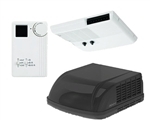|
The summer heat can be a burden while out on the road RV'ing. Having cool air to retreat to can be a trip saver and an air conditioner installed on your RV can be one of the greatest appliances you could have. An air-conditioner not only cools down your vehicle, but it also filters the air and reduces the humidity within your RV. Most RV's come with roof-mounted air conditioner's and if your RV did not come with this, it can easily be added. A roof unit can be ducted through the heating ducts or air vents and these air-conditioners run off of shore power or a generator.
|
|
Unless you prefer camping in arctic climates, the rv air conditioner is perhaps the most important accessory to ensure you and your family remain comfortable in even the hottest outdoor climates. Most all RVs now come with a rooftop air conditioning unit and for those that do not, one can easily be added. RV owners who need to add or replace an air conditioner If you need help choosing the right unit for your RV, our knowledgeable staff are here to help. RV air conditioners also require minor upkeep to ensure they operate as expected, here are a few tips to keep your unit blowing cold air.
Air Filters and Air Quality
- In addition to its well-known cooling capacity, the air conditioning unit can also filter air to remove dust, allergens, and other particles to improve air quality in the RV. Whether it's air quality or air temperature that is of the utmost importance to you and your family, keeping the filter(s) clean is one of the simplest things you can do to improve your AC unit's performance and make it last through countless summer nights. Dirty air filters can become clogged and reduce airflow as well as the overall efficient operation of the unit. To prevent problems such as this, you should follow the manufacturer's guidelines for maintaining the unit's filters.
Visual Inspection
- The plastic cover of the roof-mounted section of the air conditioning unit is called the "shroud". Check the shroud for cracks or breaks in the cover. Driving with a weakened shroud that could fly off at any moment poses an obvious danger.
Replacement shrouds are relatively inexpensive and can easily be changed out.
Annual Cleaning and Maintenance
- Most manufacturers recommend you clean the condenser coil at least once a year. This task requires climbing up onto the roof and removing the shroud to access the interior of the air conditioning unit. There are many on-line resources available that provide do-it-yourself instructions, here is a video we think is pretty thorough.
RV Air Conditioner Cleaning
RV Air Conditioner Related Articles
8/30/2024 - Overhead Clearances and Your RV
6/25/2020 - Keeping Your RV Cool in Warm Weather
4/26/2018 - Staying Comfortable in Your RV This Summer
10/14/2014 - Gree RV Air Conditioner
8/22/2014 - The Best RV Air Conditioners
6/11/2014 - All the Comforts of Home: 3 RV Accessories That Will Improve Your Next Camping Trip
|
|
|

